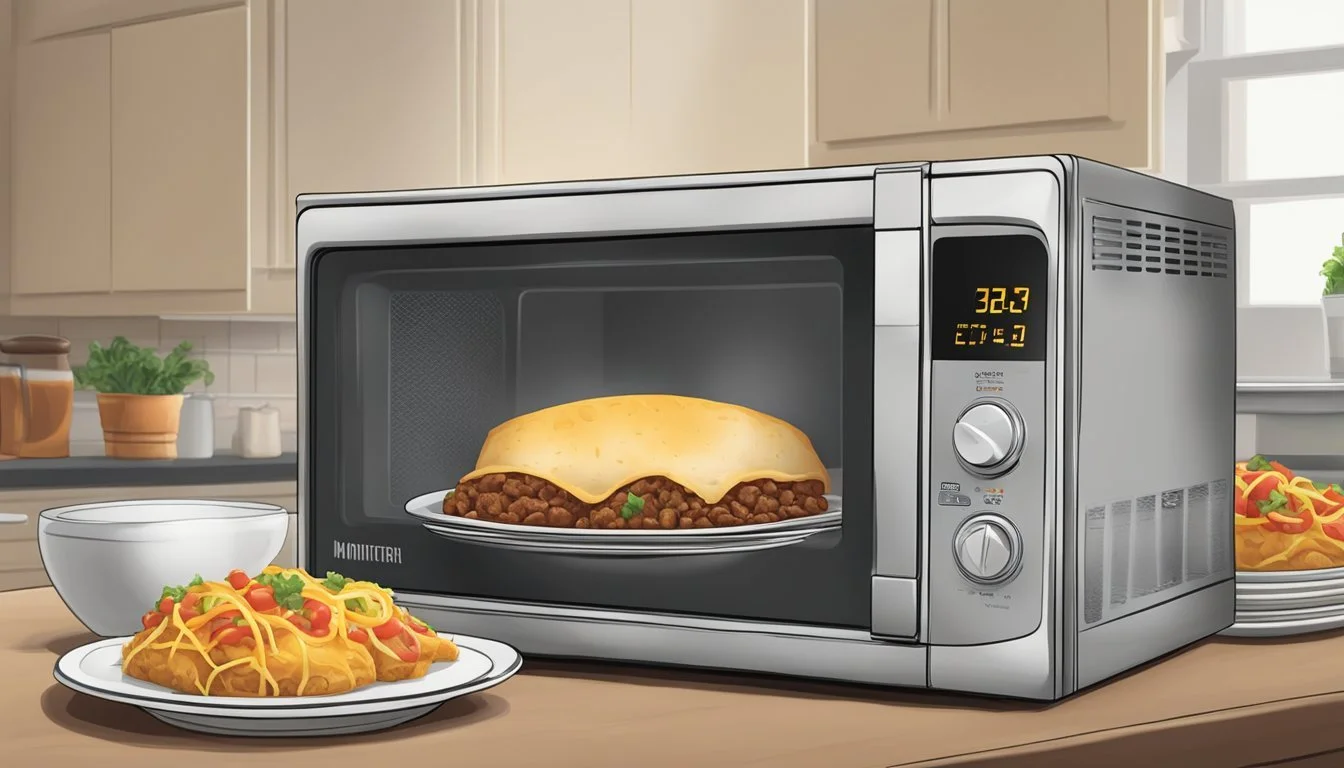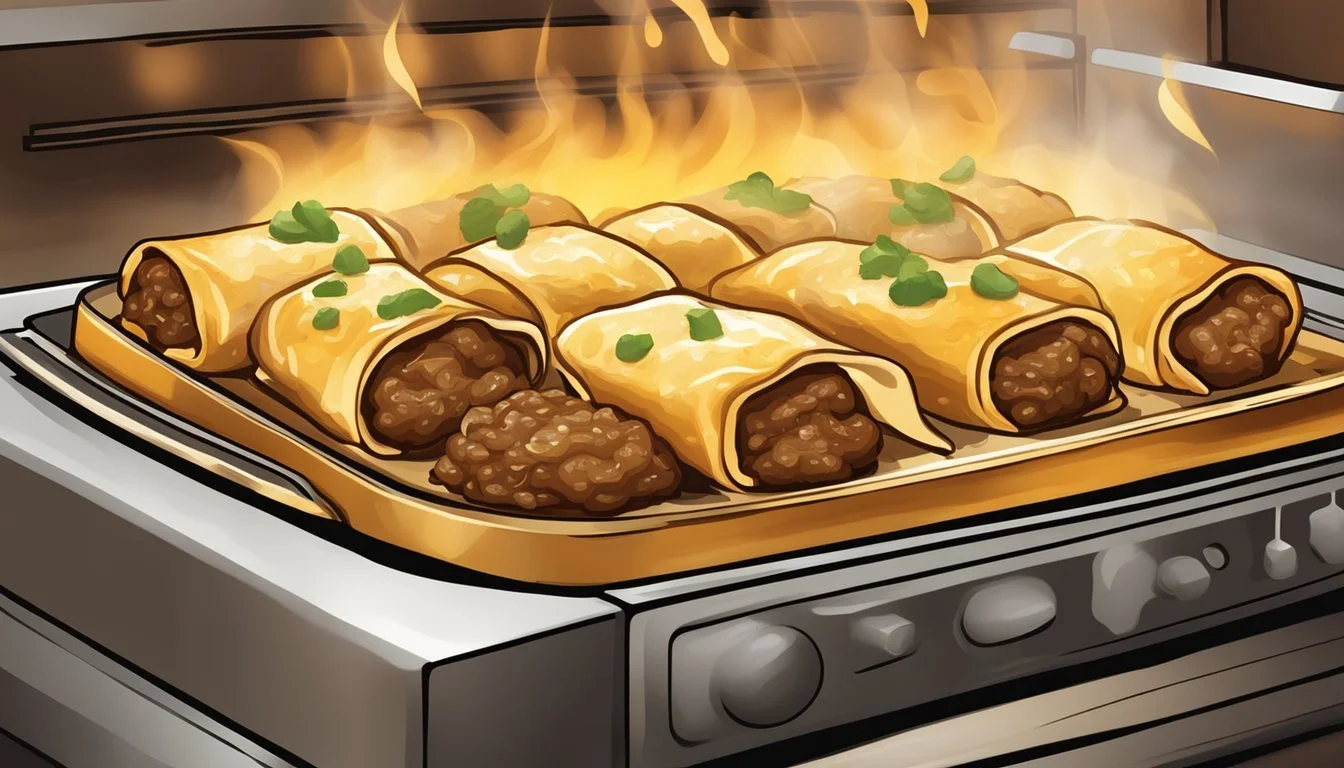How to Reheat El Monterey Beef & Cheese Chimichangas
Quick and Easy Methods
Wondering how to bring the delicious flavor and texture of El Monterey Beef & Cheese Chimichangas back to life? This blog post breaks down the most effective ways to reheat these tasty treats, ensuring they taste just as good as when they first came out of the package. The best method for reheating El Monterey Beef & Cheese Chimichangas is by using an oven, which ensures they remain crispy on the outside while heating thoroughly on the inside.
For leftover chimichangas, place them on a baking sheet and preheat your oven to 350°F. This ensures even heating and retains the mouth-watering flavor we've come to love. Whether you choose the oven, air fryer, or microwave, it's crucial to get the texture just right—crispy outside, warm and flavorful inside.
Looking for convenience? The air fryer offers a quick and efficient way to reheat your chimichangas without compromising on quality. Simply set the air fryer to 350°F, cook for about 5-10 minutes, and you'll have a crispy, delicious meal ready to enjoy.
Preparing for Reheating
When preparing to reheat El Monterey Beef & Cheese Chimichangas, it's essential to select the best reheating method and properly thaw any frozen chimichangas. This ensures optimal taste and texture.
Determining the Best Reheating Method
Choosing the proper reheating method depends on the desired result. For a crispy exterior, the oven or air fryer are ideal choices.
Oven: Preheat to 375°F. Place chimichangas on a baking sheet and cover with foil. Reheat for about 15-20 minutes.
Air Fryer: Set to 350°F. Place chimichangas in the air fryer basket, ensuring they don't touch. Reheat for 10-12 minutes.
Microwave: If convenience is the priority, wrap a chimichanga in a damp paper towel. Heat on high for 1-2 minutes, checking for hot spots.
Thawing Frozen Chimichangas
Thawing is important for even reheating. Place frozen chimichangas in the fridge for several hours or overnight.
For a quicker thaw, use the microwave's defrost setting. Place on a microwave-safe plate and defrost in short intervals, turning frequently.
Ensure chimichangas are thawed evenly before reheating to avoid cold spots. Proper thawing guarantees a delicious and uniform texture throughout the chimichanga.
By selecting the appropriate method and thawing correctly, you can enjoy reheated chimichangas that taste freshly made.
Oven Reheating Instructions
Reheating your El Monterey Beef & Cheese Chimichangas in the oven ensures they are heated thoroughly and achieve a crispy, golden-brown exterior. These steps will guide you through the process for the best results.
Preheating the Oven
Start by preheating the oven to 350°F (175°C). This temperature is ideal for warming the chimichangas evenly without burning the outer shell. Allow the oven to fully reach this temperature before placing the chimichangas inside.
An evenly heated oven ensures consistent results, making preheating a critical first step. Use an oven thermometer if needed to confirm the temperature.
Preparation of Baking Sheet
Prepare a baking sheet by lining it with either aluminum foil or parchment paper. These materials prevent sticking and facilitate easy removal after heating.
Lightly coat the foil or paper with cooking spray. This added layer helps to achieve the desired crispiness and makes cleaning up easier afterward.
Place the chimichangas on the sheet, ensuring they do not touch each other. This allows hot air to circulate around each chimichanga, promoting even heating.
Achieving a Crispy Exterior
For a crispy exterior, do not cover the chimichangas. Bake them uncovered for about 10 to 15 minutes. Keep an eye on them during this time to avoid overcooking.
Turning the chimichangas halfway through the baking process can help achieve uniform crispiness.
Upon reaching a golden brown color, remove them from the oven carefully. Let them cool for a minute before serving to enjoy the crispiness.
Microwave Reheating Method
Reheating El Monterey Beef & Cheese Chimichangas in the microwave can be quick and convenient. Utilizing the right techniques ensures the chimichangas come out hot and maintain a satisfying texture.
Using Microwave-Safe Plate
Begin by placing the chimichanga on a microwave-safe plate. Choosing the right plate is essential as some materials, like metal or certain plastics, can be unsafe or cause uneven heating.
Avoid decorative plates with gold or silver trims. For best results, use plain ceramic or glass plates marked as microwave-safe.
This helps distribute heat evenly and prevents harmful chemicals from leaching into the food. Ensure the chimichanga lies flat on the plate to promote uniform reheating.
Covering with Damp Paper Towel
Once the chimichanga is on a microwave-safe plate, cover it with a damp paper towel. This simple step is crucial to retain moisture and prevent the tortilla from becoming tough or chewy.
A dry chimichanga can significantly impact the eating experience. Moisten a paper towel under running water, then wring out the excess liquid until damp.
Place it over the chimichanga, making sure it covers the entire surface. This method helps maintain the chimichanga's texture by trapping steam during the reheating process.
Setting the Proper Duration
Set your microwave to high power and begin by heating the chimichanga for 1 minute and 30 seconds.
After this initial burst, remove the plate and flip the chimichanga. Microwaving on high for an additional 1 minute and 30 seconds, or until the internal temperature reaches a safe level, ensures even heating.
Different microwaves may vary in power, so it's important to monitor the process. If the chimichanga isn't hot enough, continue heating in 30-second increments.
Be cautious not to overheat, as this can dry out the filling and make the tortilla less pliable.
Following these steps will help achieve a well-reheated chimichanga with a pleasant texture and even temperature.
Reheating with Air Fryer
Reheating El Monterey Beef & Cheese Chimichangas in an air fryer can yield a crispy exterior and even heating. The following steps will guide you through preheating, avoiding overcrowding, and ensuring even heating.
Preheating the Air Fryer
Preheating is crucial for achieving a crispy texture. Set the air fryer to 400°F. If your air fryer has a preheat function, use it. If not, allow it to run empty until it reaches the desired temperature. A preheated air fryer ensures that the chimichangas start cooking immediately, promoting an even and consistent texture.
Avoiding Overcrowding
Overcrowding the air fryer can lead to uneven heating and soggy textures. Place the chimichangas in a single layer, leaving space between each one. This spacing allows hot air to circulate properly. If you have multiple chimichangas, cook them in batches. This method maintains the desired crispy exterior.
Ensuring Even Heating
Flip the chimichangas halfway through the cooking process. Cook them for 12-15 minutes total, adjusting the time based on your air fryer model. Check on them periodically to avoid overcooking. Even heating prevents cold spots and ensures the entire chimichanga is heated thoroughly.
Stovetop Reheating Technique
Reheating El Monterey Beef & Cheese Chimichangas on the stovetop can provide a crispy exterior and a warm, flavorful interior. Here's how to achieve perfect results every time.
Using Skillet or Pan
To begin, select a large skillet or pan that allows the chimichangas to lay flat without overlap.
Preheat the skillet over medium heat and add a small amount of oil—about 1-2 tablespoons—to ensure even crispiness.
Once the oil is shimmering, carefully place the chilled or frozen chimichangas into the skillet. Use tongs to avoid splashing hot oil.
Cook for about 3-4 minutes on each side. This method ensures the chimichangas are heated thoroughly and evenly.
Monitoring Oil Temperature
Maintaining the right oil temperature is crucial. The oil should be around 350°F (175°C) for optimal results.
Too hot, and the exterior may burn before the interior heats up. Too cool, and the chimichangas may become greasy and soggy. Use a kitchen thermometer to monitor the temperature and adjust the heat accordingly.
Frequent checks ensure consistent temperature and prevent issues that can compromise the texture and taste.
Turning for Even Crispiness
Ensure even crispiness by turning the chimichangas regularly. After the initial 3-4 minutes on one side, use tongs to flip them over.
Cook the second side for another 3-4 minutes. For extra crispiness, consider turning them a couple more times, allowing an additional 1-2 minutes per side.
This turning technique ensures that every part of the chimichanga is evenly crisp and thoroughly heated.
Monitor the internal temperature, aiming for about 165°F (75°C) to ensure they are safe to eat and enjoy.
Following these steps guarantees a perfectly reheated chimichanga with a crisp exterior and warm, melty inside.
Enhancing Flavor and Presentation
When reheating El Monterey Beef & Cheese Chimichangas, enhancing their flavor and presentation can elevate the meal. Consider choosing the right toppings, sauces, and serving styles to add more depth and appeal to the dish.
Selecting Complementary Toppings
Toppings can bring a variety of textures and flavors to chimichangas. Shredded lettuce adds a fresh, crisp element, while diced tomatoes provide juiciness and color. Shredded cheese can be melted on top for extra cheesiness. Sour cream and guacamole offer creaminess and a subtle tang.
A sprinkle of fresh cilantro can introduce a burst of freshness. Don’t forget a squeeze of lime for a zesty finish. These toppings complement the rich beef and cheese inside the chimichanga, making each bite more delicious.
Choosing Suitable Sauces
Sauces can enhance the flavor and moisture of chimichangas. Salsa is a popular choice; whether you prefer mild or spicy, it adds a vibrant taste. For a creamy option, sour cream pairs well with the savory flavors of beef and cheese.
Salsa verde brings a tangy and slightly spicy flavor that's different from traditional red salsa. For those who enjoy a bit of heat, a drizzle of hot sauce can add the perfect kick.
Consider a side of queso for dipping, providing a rich, cheesy accompaniment.
Serving Suggestions
Proper presentation can make a significant difference. Arrange the chimichangas on a plate with a side of Mexican rice and refried beans for a complete meal. Add a few slices of avocado for a touch of elegance.
Create a dipping plate with small bowls of guacamole, salsa, and sour cream. This not only looks inviting but allows everyone to personalize their chimichanga.
Additionally, consider presenting them with a sprinkle of freshly chopped cilantro and a lime wedge on the side. This can make your reheated chimichangas more appealing and engaging.
Enhancing El Monterey Beef & Cheese Chimichangas with complementary toppings, suitable sauces, and thoughtful serving suggestions ensures a more enjoyable and flavorful meal.



